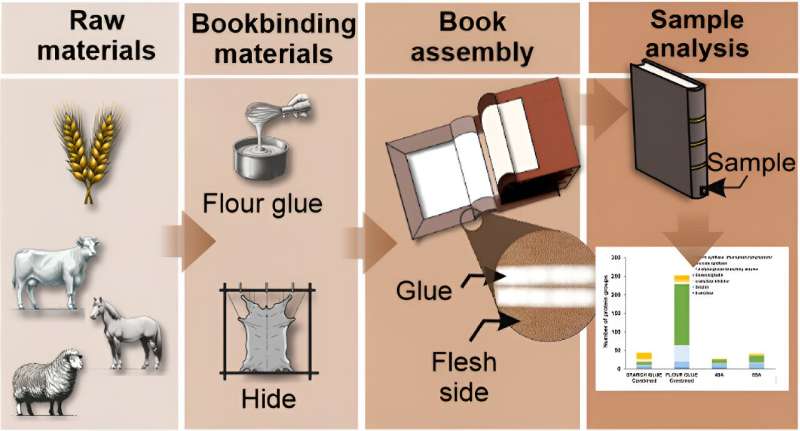Graphic summary. Credit: Journal of Proteome Research (2024). DOI: 10.1021/acs.jproteome.3c00804
“Bookworm” is a cute thing to call a voracious reader, but actual bookworms as well as microorganisms and time break down the flour pastes commonly used to keep old publications in one piece.
Now, researchers have analyzed the proteins in wheat-based glues applied to historic bookbinding to provide insights into their adhesiveness and how they degrade in the Journal of Proteome Research. This information could help conservators restore and preserve treasured books for future generations.
Wheat-based glues have been used since ancient Egypt, but little is known about their protein composition. Flour glues are made from the inside of wheat grains, which includes the gluten that is so delicious to both bookworms and microorganisms.
Starch glue, on the other hand, is made from the proteins that remain after most of the gluten is removed, making it less attractive to pests. Understanding the nature of the proteins in these glues and how they affect adhesives would help book conservators choose the best approaches and materials for their work.
So Rocio Prisby and colleagues created protein profiles for both flour and starch glues, identified differences between them, and then used this information to analyze books in the archives of the National Library of Medicine (NLM ).
To create the protein profiles, called proteomes, the researchers first extracted proteins from lab-made versions of flour and starch glues. They then used mass spectrometry data and bioinformatics software to identify the types and relative abundance of proteins in the samples.
The team found that flour glue has more proteins and a wider variety of them than starch glue. In addition, the starch glue proteins were particularly durable and flexible, making it a potentially better choice than flour glue for book repair.
The researchers then used their protein profiles to analyze samples of historic book bindings from the NLM archives. They confirmed that the adhesives were flour-based due to their gluten content and identified degraded gluten in the samples, which could indicate damage and loss of adhesion.
They also identified that the chemical breakdown of leather and glue in a book cover impact each other, possibly causing faster overall deterioration. This work provides information that could indicate to a conservator the need for repair, potentially preventing a book from being damaged or destroyed.
More broadly, the researchers say the results demonstrate the potential of protein analysis to guide conservation efforts.
More information:
Rocio Prisby et al, Wheat-based cabbages in conservation and cultural heritage: (proteome dissolution of flour and starch pastes and their adhering properties), Journal of Proteome Research (2024). DOI: 10.1021/acs.jproteome.3c00804
Provided by the American Chemical Society
Subpoena: Secret to saving old books could be gluten-free glues (2024, April 25) retrieved April 26, 2024 from https://phys.org/news/2024-04-secret-gluten-free.html
This document is subject to copyright. Other than any fair dealing for private study or research purposes, no part may be reproduced without written permission. Content is provided for informational purposes only.
#secret #saving #books #glutenfree #glues
Image Source : phys.org
